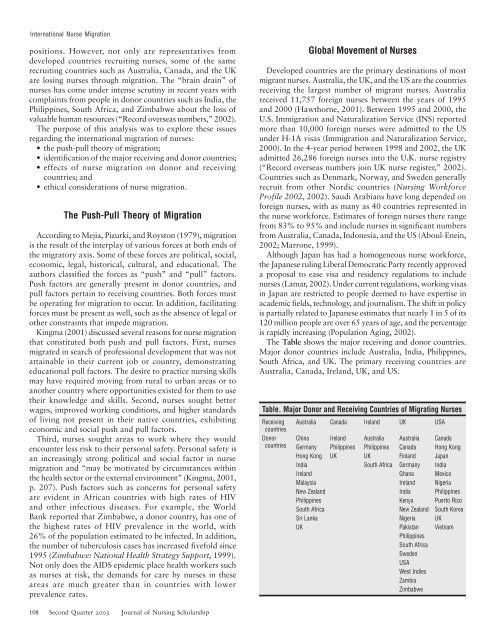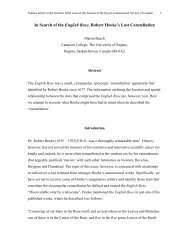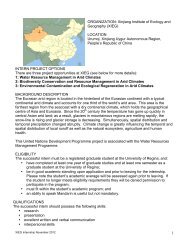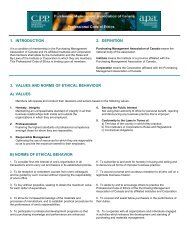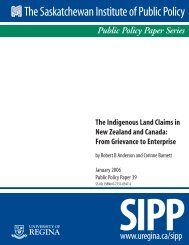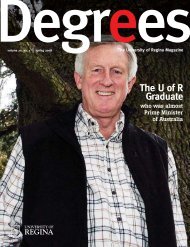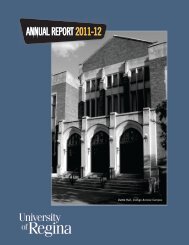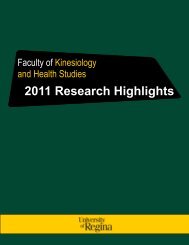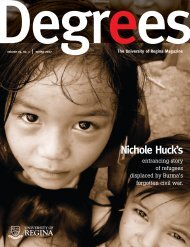<strong>International</strong> <strong>Nurse</strong> <strong>Migration</strong>positions. However, not only are representatives fromdeveloped countries recruit<strong>in</strong>g nurses, some <strong>of</strong> the samerecruit<strong>in</strong>g countries such as Australia, Canada, <strong>and</strong> the UKare los<strong>in</strong>g nurses through migration. The “bra<strong>in</strong> dra<strong>in</strong>” <strong>of</strong>nurses has come under <strong>in</strong>tense scrut<strong>in</strong>y <strong>in</strong> recent years withcompla<strong>in</strong>ts from people <strong>in</strong> donor countries such as India, thePhilipp<strong>in</strong>es, South Africa, <strong>and</strong> Zimbabwe about the loss <strong>of</strong>valuable human resources (“Record overseas numbers,” 2002).The purpose <strong>of</strong> this analysis was to explore these issuesregard<strong>in</strong>g the <strong>in</strong>ternational migration <strong>of</strong> nurses:• the push-pull theory <strong>of</strong> migration;• identification <strong>of</strong> the major receiv<strong>in</strong>g <strong>and</strong> donor countries;• effects <strong>of</strong> nurse migration on donor <strong>and</strong> receiv<strong>in</strong>gcountries; <strong>and</strong>• ethical considerations <strong>of</strong> nurse migration.The <strong>Push</strong>-<strong>Pull</strong> Theory <strong>of</strong> <strong>Migration</strong>Accord<strong>in</strong>g to Mejia, Pizurki, <strong>and</strong> Royston (1979), migrationis the result <strong>of</strong> the <strong>in</strong>terplay <strong>of</strong> various forces at both ends <strong>of</strong>the migratory axis. Some <strong>of</strong> these forces are political, social,economic, legal, historical, cultural, <strong>and</strong> educational. Theauthors classified the forces as “push” <strong>and</strong> “pull” factors.<strong>Push</strong> factors are generally present <strong>in</strong> donor countries, <strong>and</strong>pull factors perta<strong>in</strong> to receiv<strong>in</strong>g countries. Both forces mustbe operat<strong>in</strong>g for migration to occur. In addition, facilitat<strong>in</strong>gforces must be present as well, such as the absence <strong>of</strong> legal orother constra<strong>in</strong>ts that impede migration.K<strong>in</strong>gma (2001) discussed several reasons for nurse migrationthat constituted both push <strong>and</strong> pull factors. First, nursesmigrated <strong>in</strong> search <strong>of</strong> pr<strong>of</strong>essional development that was notatta<strong>in</strong>able <strong>in</strong> their current job or country, demonstrat<strong>in</strong>geducational pull factors. The desire to practice nurs<strong>in</strong>g skillsmay have required mov<strong>in</strong>g from rural to urban areas or toanother country where opportunities existed for them to usetheir knowledge <strong>and</strong> skills. Second, nurses sought betterwages, improved work<strong>in</strong>g conditions, <strong>and</strong> higher st<strong>and</strong>ards<strong>of</strong> liv<strong>in</strong>g not present <strong>in</strong> their native countries, exhibit<strong>in</strong>geconomic <strong>and</strong> social push <strong>and</strong> pull factors.Third, nurses sought areas to work where they wouldencounter less risk to their personal safety. Personal safety isan <strong>in</strong>creas<strong>in</strong>gly strong political <strong>and</strong> social factor <strong>in</strong> nursemigration <strong>and</strong> “may be motivated by circumstances with<strong>in</strong>the health sector or the external environment” (K<strong>in</strong>gma, 2001,p. 207). <strong>Push</strong> factors such as concerns for personal safetyare evident <strong>in</strong> African countries with high rates <strong>of</strong> HIV<strong>and</strong> other <strong>in</strong>fectious diseases. For example, the WorldBank reported that Zimbabwe, a donor country, has one <strong>of</strong>the highest rates <strong>of</strong> HIV prevalence <strong>in</strong> the world, with26% <strong>of</strong> the population estimated to be <strong>in</strong>fected. In addition,the number <strong>of</strong> tuberculosis cases has <strong>in</strong>creased fivefold s<strong>in</strong>ce1995 (Zimbabwe: National Health Strategy Support, 1999).Not only does the AIDS epidemic place health workers suchas nurses at risk, the dem<strong>and</strong>s for care by nurses <strong>in</strong> theseareas are much greater than <strong>in</strong> countries with lowerprevalence rates.Global Movement <strong>of</strong> <strong>Nurse</strong>sDeveloped countries are the primary dest<strong>in</strong>ations <strong>of</strong> mostmigrant nurses. Australia, the UK, <strong>and</strong> the US are the countriesreceiv<strong>in</strong>g the largest number <strong>of</strong> migrant nurses. Australiareceived 11,757 foreign nurses between the years <strong>of</strong> 1995<strong>and</strong> 2000 (Hawthorne, 2001). Between 1995 <strong>and</strong> 2000, theU.S. Immigration <strong>and</strong> Naturalization Service (INS) reportedmore than 10,000 foreign nurses were admitted to the USunder H-1A visas (Immigration <strong>and</strong> Naturalization Service,2000). In the 4-year period between 1998 <strong>and</strong> 2002, the UKadmitted 26,286 foreign nurses <strong>in</strong>to the U.K. nurse registry(“Record overseas numbers jo<strong>in</strong> UK nurse register,” 2002).Countries such as Denmark, Norway, <strong>and</strong> Sweden generallyrecruit from other Nordic countries (Nurs<strong>in</strong>g WorkforcePr<strong>of</strong>ile 2002, 2002). Saudi Arabians have long depended onforeign nurses, with as many as 40 countries represented <strong>in</strong>the nurse workforce. Estimates <strong>of</strong> foreign nurses there rangefrom 83% to 95% <strong>and</strong> <strong>in</strong>clude nurses <strong>in</strong> significant numbersfrom Australia, Canada, Indonesia, <strong>and</strong> the US (Aboul-Ene<strong>in</strong>,2002; Marrone, 1999).Although Japan has had a homogeneous nurse workforce,the Japanese rul<strong>in</strong>g Liberal Democratic Party recently approveda proposal to ease visa <strong>and</strong> residency regulations to <strong>in</strong>cludenurses (Lamar, 2002). Under current regulations, work<strong>in</strong>g visas<strong>in</strong> Japan are restricted to people deemed to have expertise <strong>in</strong>academic fields, technology, <strong>and</strong> journalism. The shift <strong>in</strong> policyis partially related to Japanese estimates that nearly 1 <strong>in</strong> 5 <strong>of</strong> its120 million people are over 65 years <strong>of</strong> age, <strong>and</strong> the percentageis rapidly <strong>in</strong>creas<strong>in</strong>g (Population Ag<strong>in</strong>g, 2002).The Table shows the major receiv<strong>in</strong>g <strong>and</strong> donor countries.Major donor countries <strong>in</strong>clude Australia, India, Philipp<strong>in</strong>es,South Africa, <strong>and</strong> UK. The primary receiv<strong>in</strong>g countries areAustralia, Canada, Irel<strong>and</strong>, UK, <strong>and</strong> US.Table. Major Donor <strong>and</strong> Receiv<strong>in</strong>g Countries <strong>of</strong> Migrat<strong>in</strong>g <strong>Nurse</strong>sReceiv<strong>in</strong>g Australia Canada Irel<strong>and</strong> UK USAcountriesDonor Ch<strong>in</strong>a Irel<strong>and</strong> Australia Australia Canadacountries Germany Philipp<strong>in</strong>es Philipp<strong>in</strong>es Canada Hong KongHong Kong UK UK F<strong>in</strong>l<strong>and</strong> JapanIndia South Africa Germany IndiaIrel<strong>and</strong> Ghana MexicoMalaysia Irel<strong>and</strong> NigeriaNew Zeal<strong>and</strong> India Philipp<strong>in</strong>esPhilipp<strong>in</strong>es Kenya Puerto RicoSouth Africa New Zeal<strong>and</strong> South KoreaSri Lanka Nigeria UKUK Pakistan VietnamPhilipp<strong>in</strong>esSouth AfricaSwedenUSAWest IndiesZambiaZimbabwe108 Second Quarter 2003 Journal <strong>of</strong> Nurs<strong>in</strong>g Scholarship
<strong>International</strong> <strong>Nurse</strong> <strong>Migration</strong>Not only are <strong>in</strong>dustrialized countries recruit<strong>in</strong>g from oneanother, develop<strong>in</strong>g countries also recruit nurses, <strong>of</strong>ten with<strong>in</strong>the same geographic area. For example, Caribbean <strong>and</strong>southern African countries recruit from each other (“Recordoverseas numbers jo<strong>in</strong> UK nurse register,” 2002). The number<strong>of</strong> foreign nurses admitted to the US is expected to <strong>in</strong>creasewith the proposed revision <strong>of</strong> immigration requirements(H-1C visas). The revisions would allow entry <strong>of</strong> foreign RNs<strong>in</strong>to the US to work <strong>in</strong> hospitals on a temporary basis <strong>in</strong>areas most acutely affected by the nurse shortage (“Senatepasses workforce legislation,” 2001).Effects <strong>of</strong> <strong>Migration</strong> on Donor <strong>and</strong> Receiv<strong>in</strong>g CountriesThe movement <strong>of</strong> nurses from donor to receiv<strong>in</strong>g countriescan create hardships <strong>in</strong> donor countries because <strong>of</strong> the loss <strong>of</strong>skilled personnel <strong>and</strong> loss <strong>of</strong> economic <strong>in</strong>vestment <strong>in</strong>education. The migration <strong>of</strong> nurses from develop<strong>in</strong>g countries,such as from African countries, results <strong>in</strong> the loss <strong>of</strong> “scarce<strong>and</strong> relatively expensive-to-tra<strong>in</strong> resources” (Buchan, 2001,p. 204). Many African countries have had significant <strong>in</strong>creases<strong>in</strong> <strong>in</strong>cidence <strong>and</strong> prevalence <strong>of</strong> <strong>in</strong>fectious diseases such asAIDS, malaria, <strong>and</strong> tuberculosis, thus plac<strong>in</strong>g further dem<strong>and</strong>son already overburdened health care systems. The WorldHealth Organization (WHO) reported that at the end <strong>of</strong> 2000,25.3 million people <strong>in</strong> Sub-Saharan Africa had HIV/AIDS(WHO, 2000). Difficulties created by migration particularlyfrom the Sub-Saharan region come less from the loss <strong>of</strong> people<strong>in</strong> absolute numbers than from the loss <strong>of</strong> the few qualifiedpr<strong>of</strong>essionals (Ojo, 1990). The loss <strong>of</strong> nurses <strong>in</strong> this regionresults <strong>in</strong> even fewer skilled nurses, <strong>in</strong>creased care dem<strong>and</strong>son the nurses who rema<strong>in</strong>, <strong>and</strong> further deterioration <strong>of</strong><strong>in</strong>adequate health care systems.In addition to African countries, some other donor countriesalso have scarce nurse resources <strong>and</strong> can ill afford to losenurses to migration. WHO (1998) estimates showed thedistribution <strong>of</strong> health personnel per 100,000 <strong>of</strong> the population.Ch<strong>in</strong>a, India, <strong>and</strong> Pakistan <strong>in</strong>dicated 99, 45, <strong>and</strong> 34 nursesrespectively per 100,000 persons. In comparison, the USreported 972 nurses (for 1996), the UK reported 870 nurses(for 2000; Buchan & Seccombe, 2002), Australia reported830 nurses (for 1998), Canada reported 897 nurses (for 1996),<strong>and</strong> Irel<strong>and</strong> reported 1,593 nurses (for 1998) per 100,000persons.Reports from the Philipp<strong>in</strong>es are mixed regard<strong>in</strong>g effectson the health care system <strong>and</strong> the economy when largenumbers <strong>of</strong> nurses leave for other countries. The migration <strong>of</strong>Filip<strong>in</strong>o nurses is an example <strong>of</strong> the push factors <strong>of</strong> theeconomic conditions <strong>of</strong> oversupply, m<strong>in</strong>imal employmentopportunities, <strong>and</strong> the political factors <strong>of</strong> an aggressive exportpolicy (Hawthorne, 2001). Sison (2002) reported that Filip<strong>in</strong>ogovernment <strong>of</strong>ficials viewed the export<strong>in</strong>g <strong>of</strong> nurses as a newgrowth area for overseas employment. The 175 nurs<strong>in</strong>gschools <strong>in</strong> the Philipp<strong>in</strong>es produce more than 9,000 graduatesyearly, <strong>of</strong> whom 5,000 to 7,000 become licensed.Governmental encouragement for nurse migration isunderst<strong>and</strong>able, given the amount <strong>of</strong> money returned to thecountry <strong>in</strong> remittances. L<strong>in</strong>dquist (1993) reported over $800million received <strong>in</strong> remuneration per year from Filip<strong>in</strong>os liv<strong>in</strong>gabroad, money on which the Filip<strong>in</strong>o economy had becomehighly dependent. Filip<strong>in</strong>o nurses are sought <strong>in</strong> many Englishspeak<strong>in</strong>gcountries because <strong>of</strong> the Western-oriented nurs<strong>in</strong>gcurriculums with English as the primary <strong>in</strong>structive language,mak<strong>in</strong>g Filip<strong>in</strong>o nurses “marketable to foreign countries”(Ort<strong>in</strong>, 1990, p. 11).However, Prystay (2002) reported that nurs<strong>in</strong>g directors <strong>in</strong>the Philipp<strong>in</strong>es were greatly concerned about the high turnoverrates, with novice nurses staff<strong>in</strong>g hospital wards <strong>and</strong> operat<strong>in</strong>grooms. In addition to los<strong>in</strong>g experienced staff nurses, the<strong>University</strong> <strong>of</strong> Santo Tomas reportedly lost one-fourth <strong>of</strong> itsteach<strong>in</strong>g staff <strong>in</strong> 2001 to overseas hospitals. The Filip<strong>in</strong>o nurseswho rema<strong>in</strong> face (a) steep competition for jobs <strong>and</strong> poor wages,(b) little <strong>in</strong>centive from governmental health <strong>of</strong>ficials toimprove wages <strong>and</strong> work<strong>in</strong>g conditions, <strong>and</strong> (c) shortage <strong>of</strong>experienced nurs<strong>in</strong>g <strong>in</strong>structors.The effect on receiv<strong>in</strong>g countries is positive <strong>in</strong> that countriesreceive skilled nurses who can enter the workforce withm<strong>in</strong>imal preparation to fill critical shortages. On an averageday, the UK uses 20,000 temporary or agency nurses to fillshortage positions <strong>in</strong> hospitals, cost<strong>in</strong>g the NHS $1,235million USD a year (F<strong>in</strong>alyson, Dixon, Meadows, & Blair,2002a). In the US, agency nurses can earn $50 per hour or$104,000 per year. <strong>Nurse</strong>s who work as travel<strong>in</strong>g nurses canearn $75 per hour or $156,000 per year (Gamble, 2002). Thecost <strong>of</strong> employ<strong>in</strong>g foreign nurses is a much less expensivemethod <strong>of</strong> fill<strong>in</strong>g vacant positions. One hospital <strong>in</strong> Kentuckyrecently recruited 50 nurses from the Philipp<strong>in</strong>es at the cost<strong>of</strong> $300,000, which was roughly what the hospital paid foragency nurses for 1 month (Dooley, 2002).Nurs<strong>in</strong>g leaders <strong>in</strong> the US are concerned about the use <strong>of</strong>immigration as a means to address the nurs<strong>in</strong>g shortage.Glaessel-Brown (1998) reported that us<strong>in</strong>g foreign nurses as“readily available, expendable workers postpones susta<strong>in</strong>edefforts to resolve pr<strong>of</strong>essional problems lead<strong>in</strong>g to a morestable work force <strong>and</strong> self-susta<strong>in</strong><strong>in</strong>g cycles” (p. 327). In hertestimony before the House Education <strong>and</strong> WorkforceCommittee, Mary Foley (2001), then president <strong>of</strong> the American<strong>Nurse</strong>s Association, echoed Glaessel-Brown’s op<strong>in</strong>ion thatus<strong>in</strong>g foreign nurses to fill shortage positions only delayedaction on the serious workplace issues that have drivenAmerican nurses away from the pr<strong>of</strong>ession.Ethical ConcernsAs the level <strong>of</strong> migration <strong>in</strong>creases, the ethics <strong>of</strong><strong>in</strong>ternational recruitment warrant consideration. The<strong>International</strong> Council <strong>of</strong> <strong>Nurse</strong>s’ (ICN) position statement(ICN, 2002) <strong>in</strong>dicated the right <strong>of</strong> nurses to migrate, but italso acknowledged the adverse effects that migration mighthave on the quality <strong>of</strong> health care <strong>in</strong> donor countries. TheICN condemned the practice <strong>of</strong> recruit<strong>in</strong>g nurses to countrieswhere human resource plann<strong>in</strong>g <strong>and</strong> problems related toJournal <strong>of</strong> Nurs<strong>in</strong>g Scholarship Second Quarter 2003 109


